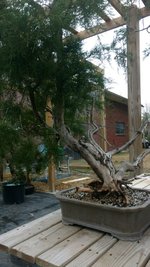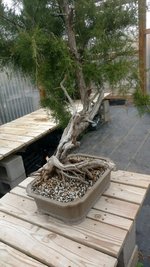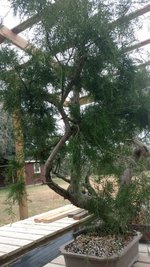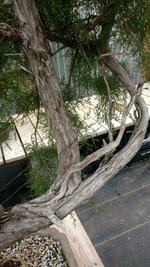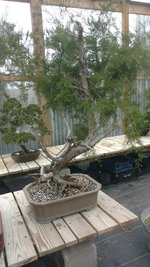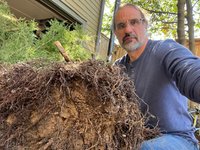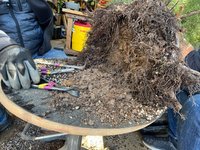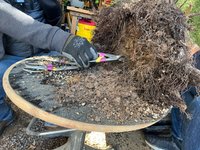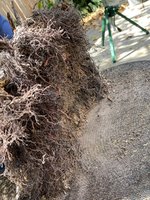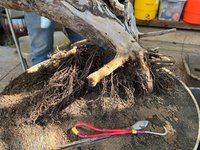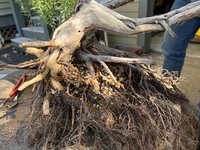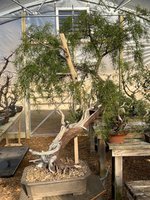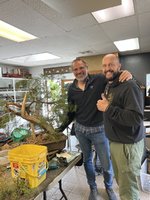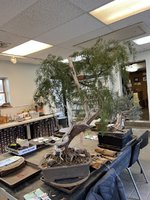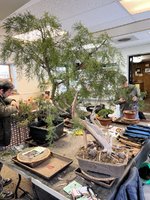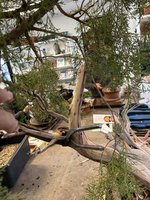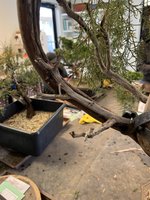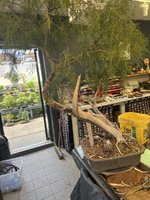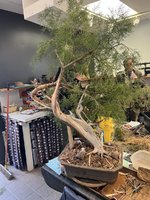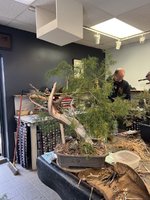You are using an out of date browser. It may not display this or other websites correctly.
You should upgrade or use an alternative browser.
You should upgrade or use an alternative browser.
Ashe juniper from Victoria TX
- Thread starter markyscott
- Start date
markyscott
Imperial Masterpiece
markyscott
Imperial Masterpiece
Despite getting blown off the bench during a freak storm, it grew well all summer, seeming to like its new Virginia home. Unfortunately, the fall broke the pot. I strapped the pieces together and secured it better to the bench and let it grow the rest of the season. Last week, I slip potted it into a replacement pot, securing it carefully as there will be some heavy bending later this spring. Here’s the tree after repotting.
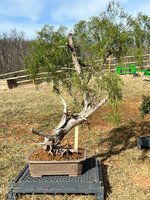

markyscott
Imperial Masterpiece
Eckhoffw
Masterpiece
Awesome. Curious to see how you treat that center trunk. Carved way back after it’s done it’s job?After the repot, I found the live vein and carefully followed it up the trunk defining the edge of the vein. I then scraped away the bark from the deadwood and preserved it. Here’s the tree after the deadwood work.
View attachment 473558
Do you know of a good tutorial on locating and defining live vein?
Michael P
Omono
Ashe juniper, the Holy Grail of Texas native bonsai. It has made many strong men weep.
markyscott
Imperial Masterpiece
It’ll be a jin, but reduced significantly in size. I’ll decide by how much it will be reduced during styling, but I think it will be significantly smaller. It’s just kind of boring - straight and no taper.Awesome. Curious to see how you treat that center trunk. Carved way back after it’s done it’s job?
Do you know of a good tutorial on locating and defining live vein?
In terms of a tutorial, I think that Bjorn has a pretty good one on BonsaiU. I’ll give you the basics. First, identify the areas that are clearly alive and the areas that are clearly dead. In this case the area just below the straight trunk is clearly dead. Sometimes, especially with old, collected trees, the live vein will have swelled beneath the bark relative to the dead wood and that can help. I use a small gouge and slowly work from the deadwood to the live vein and I remove a small piece of bark. When you get to the live vein, you’ll notice a distinct color difference - under the deadwood the exposed sapwood will be a light yellowish brown color. Under the live vein, the sapwood will be much lighter in color - almost white. Sometimes you’ll see a little pink as well. Now you know where the live vein is at one point. Repeat several times until you have identified the trace of the live vein under the bark. Then I mark it with a permanent marker and use a sharp knife to cut through the bark all along the edge of the vein. Then I have a set of different shaped Jin tools that I use to scrape the bark all along the line. You can use increasingly aggressive tools the further you get away from the live vein. I use a bark stripper once I have things down. Just remember - every bit of foliage is connected to a vein or veins on the trunk. Trees commonly have more than one live vein. So before you just start in with the bark scraper, make sure your positive that you know exactly where the live vein is and that you have found them all.
S
Eckhoffw
Masterpiece
Thank you very much for your detailed reply!. This really helps.It’ll be a jin, but reduced significantly in size. I’ll decide by how much it will be reduced during styling, but I think it will be significantly smaller. It’s just kind of boring - straight and no taper.
In terms of a tutorial, I think that Bjorn has a pretty good one on BonsaiU. I’ll give you the basics. First, identify the areas that are clearly alive and the areas that are clearly dead. In this case the area just below the straight trunk is clearly dead. Sometimes, especially with old, collected trees, the live vein will have swelled beneath the bark relative to the dead wood and that can help. I use a small gouge and slowly work from the deadwood to the live vein and I remove a small piece of bark. When you get to the live vein, you’ll notice a distinct color difference - under the deadwood the exposed sapwood will be a light yellowish brown color. Under the live vein, the sapwood will be much lighter in color - almost white. Sometimes you’ll see a little pink as well. Now you know where the live vein is at one point. Repeat several times until you have identified the trace of the live vein under the bark. Then I mark it with a permanent marker and use a sharp knife to cut through the bark all along the edge of the vein. Then I have a set of different shaped Jin tools that I use to scrape the bark all along the line. You can use increasingly aggressive tools the further you get away from the live vein. I use a bark stripper once I have things down. Just remember - every bit of foliage is connected to a vein or veins on the trunk. Trees commonly have more than one live vein. So before you just start in with the bark scraper, make sure your positive that you know exactly where the live vein is and that you have found them all.
S
I only have a couple mature trees that I’d like to do this type of work, but have been hesitant.
markyscott
Imperial Masterpiece
FYI - the BonsaiU episode I was thinking of is ”Species Guide - Junipers”.Thank you very much for your detailed reply!. This really helps.
I only have a couple mature trees that I’d like to do this type of work, but have been hesitant.
- S
chicago1980
Omono
- Messages
- 1,407
- Reaction score
- 2,668
Great Ashe Juniper. A favorite species of mine.After the repot, I found the live vein and carefully followed it up the trunk defining the edge of the vein. I then scraped away the bark from the deadwood and preserved it. Here’s the tree after the deadwood work.
View attachment 473558
Looking forward to the first styling.
markyscott
Imperial Masterpiece
markyscott
Imperial Masterpiece
markyscott
Imperial Masterpiece
markyscott
Imperial Masterpiece
Similar threads
- Replies
- 4
- Views
- 1K
- Replies
- 6
- Views
- 1K

